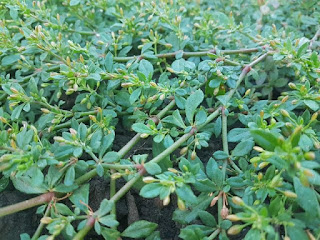PURSLANE
(Portulaca Oleracea)
(Papait)
(Papait)
HEALTH BENEFITS
Control blood sugar level
Prevent headaches
Good for the heart
Lower blood pressure level
Boost immune system
Strengthen bone
PROPERTIES
Anti-oxidant
Antifungal
Antimicrobial
Anti-inflammatory
Antidiabetic
Anthelmintic
Antiseptic
Purslane is a slender, spreading or ascending, smooth, branched, annual herb, with branches as long as 10 to 40 centimeters. Leaves are opposite or whorled, spatulate, oblanceolate to oblong-obovate, 1 to 3 centimeters long, and up to 1 centimeter wide. Flowers are white and fascicled, with slender stalks up to 1 centimeter long. Sepals are 3 to 3.5 millimeters long. Capsule is ellipsoid, a little shorted than the sepals. Seeds are numerous and covered with raised tubular points.
Purslane has a long history of use in traditional/alternative medicine.
It is also high in many nutrients. A 100 gram (3.5 oz) portion contains
Vitamin A (beta-carotene): 26% of the DV.
Vitamin C: 35% of the DV.
Magnesium: 17% of the DV.
Manganese: 15% of the DV.
Potassium: 14% of the DV.
Iron: 11% of the DV.
Calcium: 7% of the RDI.
It also contains small amounts of vitamins B1, B2, B3, folate, copper and phosphorus.
Purslane is a a weed that grows in many parts of the world. It is also a highly nutritious vegetable that can be eaten raw or cooked.
Purslane is much higher in omega-3 fatty acids than other greens. It contains high amounts of ALA, but also trace amounts of EPA, a more biologically active form of omega-3.
Purslane is very high in antioxidants and beneficial plant compounds, which may have various health benefits.
Several important minerals are found in purslane, including potassium, magnesium and calcium.
Purslane contains oxalates, which can reduce the absorption of some minerals and contribute to the formation of kidney stones.
Purslane has a long history of use in traditional/alternative medicine.
It is also high in many nutrients. A 100 gram (3.5 oz) portion contains
Vitamin A (beta-carotene): 26% of the DV.
Vitamin C: 35% of the DV.
Magnesium: 17% of the DV.
Manganese: 15% of the DV.
Potassium: 14% of the DV.
Iron: 11% of the DV.
Calcium: 7% of the RDI.
It also contains small amounts of vitamins B1, B2, B3, folate, copper and phosphorus.
Purslane is a a weed that grows in many parts of the world. It is also a highly nutritious vegetable that can be eaten raw or cooked.
Purslane is much higher in omega-3 fatty acids than other greens. It contains high amounts of ALA, but also trace amounts of EPA, a more biologically active form of omega-3.
Purslane is very high in antioxidants and beneficial plant compounds, which may have various health benefits.
Several important minerals are found in purslane, including potassium, magnesium and calcium.
Purslane contains oxalates, which can reduce the absorption of some minerals and contribute to the formation of kidney stones.

No comments:
Post a Comment